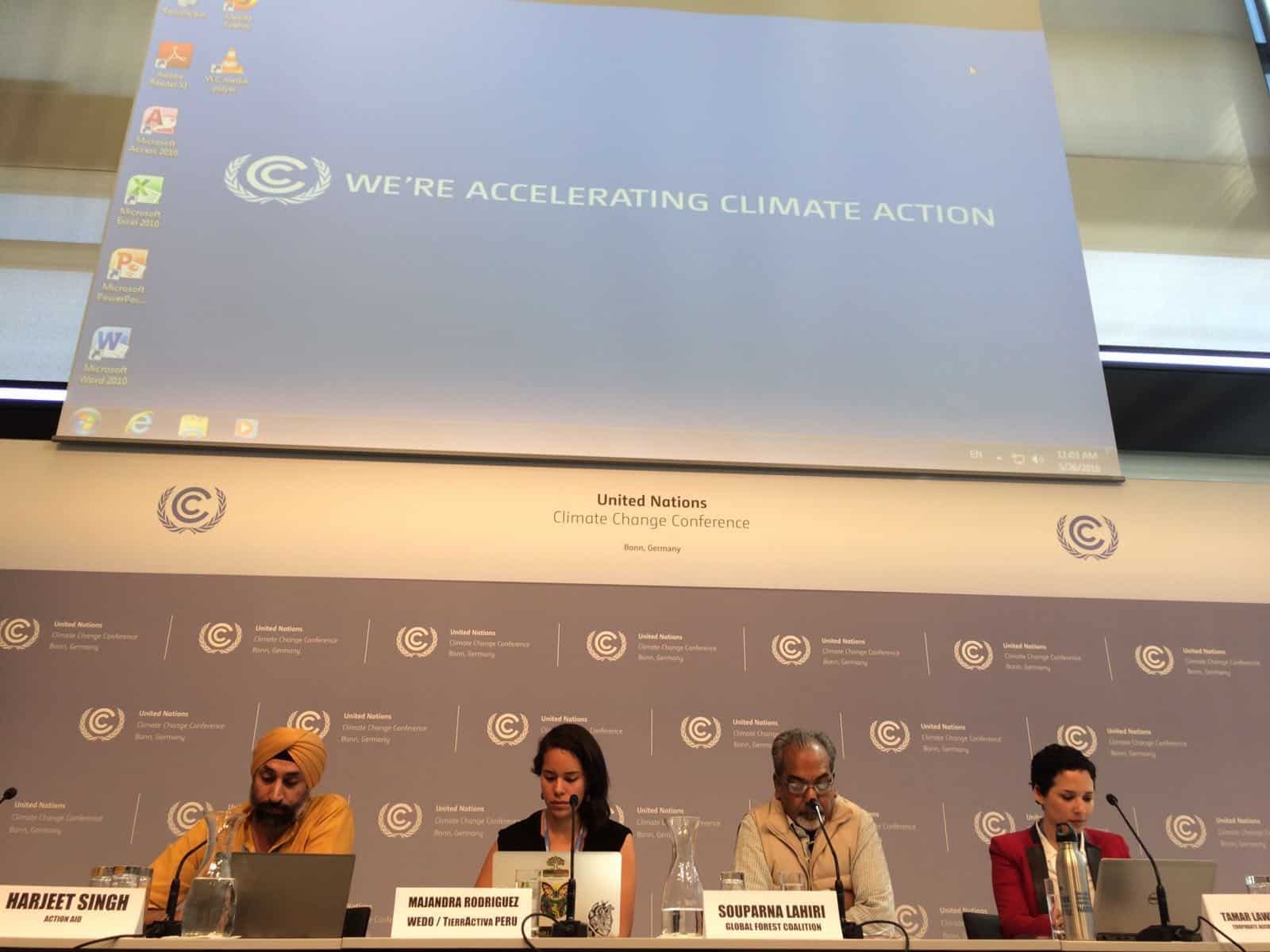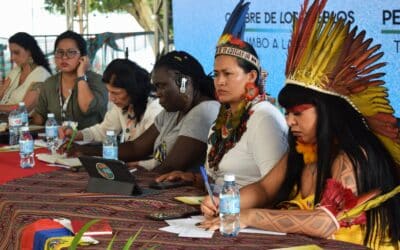By Souparna Lahiri*
The last time I survived more than a week in a climate meeting was during the inter-sessional in Bangkok in the September of 2009. But, that was, in a way, very different from Bonn. Apart from usual negotiations, civil society meetings and workshops, there were protests, colourful rallies and marches. The atmosphere was electrifying and Copenhagen was only three months away.
This was Bonn of 2016, a clear five months after the Paris Agreement and perhaps the only UNFCCC meeting taking place before the next COP in Marrakesh. The weather was gloomy with intermittent rains and a rare sunshine. The presence of Climate Justice Groups was severely limited and media contingents were a rarity. Fresh air in the World Convention Centre inside the heavily sanitized UN Campus was a rarity too (except for the smokers!).
Therefore, the very key to survival was making our presence, however limited it was, felt in the closed corridors of negotiations, sharing activities and moving towards a somewhat clear understanding and analysis of the Paris Agreement and preparing a CJN strategy roadmap to Marrakesh not forgetting the implementation of the pre-2020 commitments under Kyoto Protocol. That spirit very much existed in the daily 9 am meetings of the Geneva Group and the 1 pm or a late evening huddle of the CJN.
An uneasy first week
Though the CJN groups managed to set the tone in the first week of Bonn through the GFC sponsored side event “Will Paris Agreement undermine SDG 15.2” and the Press Briefing on “Unfinished pledges in Climate Finance, increasing private sector involvement in climate finance and the still continuing subsidies to the fossil fuel industry”, the week was a dampener but an eye opener too.
The power dynamics enjoyed by the developed countries showed its ugly face again and again in first, blocking any reference to the implementation of the Doha Amendment and second Commitment Period of the Kyoto Protocol, secondly, by undermining the delicate balance of issues arrived at in the Paris Agreement (adaptation and finance for example), thirdly, ignoring the important issues related to equity and CBDR and finally by trying to influence the agenda of the Adhoc Working Group on Paris Agreement (APA). Three days were lost, as a result, to resolve the now famous agenda fight in the APA.
GFC, on behalf of CJN, delivered a strong submissionin the opening plenary of the Subsidiary Body for Implementation (SBI), expressing deep concern over the gap between funding pledges and actual realities making way for private sector contributions and corporate controlover public policy making undermining public governance. The submission called upon the SBI to work towards phasing out perverse incentives including incentives to fossil fuel and industrial livestock production sectors and redirect such incentives and funding opportunities to public initiatives and vulnerable groups such as the indigenous peoples, local communities and women.The discussion on LULUCF remained locked on the issue of opening up of the definition of ‘revegetation’. In the CDM front, there was no consensus on the issue of changes on modalities and procedures and the negotiations on the joint implementation mechanism did not yield any result.
This week also saw a mounting pressure by the CJN and other civil society groups for opening up informal consultations, contact group discussions and other meetings to observers and a few closed meetings were also challenged. The developing country groups also supported the issue of meetings being opened to observers and managed to hold on to the demand of forming not more than two parallel contact groups since many countries have small delegations and are not equipped with the capacity to attend several parallel discussions.
A somewhat redeemed second week
The second week in Bonn had fewer CJN people around but managed to stick together and make short but sharp interventions. CJN had already in its discussions with the APA co-chairs pointed out the lack of transparency in procedures to select facilitators and who will select them, how the views of the parties will be captured while moving forward, lack of space in the agenda to discuss loss and damage and expressed concern that there is an effort to re-negotiate the delicate balance of the Paris Agreement. The CJN submission urged the co-chairs “to be cautious in how you frame questions to Parties to ensure that neither the Paris Agreement nor its mother Convention are re-negotiated”.
A very strong position articulated and taken up by the GFC “to keep land and forest sector out of market and sustainable development mechanism” was highlighted in the meeting with the EU, US and other country delegations and affirmed in the Press Briefing on 26th May, the last day of the Bonn Conference.
The re-convening of the APA in the second week was a sigh of relief although the negotiations were mired in the issues of equity and CBDR and the sovereignty of countries over their contents in the NDCs, adaptation vs mitigation and introduction of terms like non binding and binding obligations. There was some progress on the agenda and the work programme though the agenda discussion on the entry of force of the Paris Agreement created quite a confusion over whether APA has to be suspended and CMA started if the date of entry of force preceded Marrakesh. There was a general apprehension among the developing countries that the developed bloc wanted an early entry of force to block those countries which were still to ratify, from negotiations.
The closing plenary of the SBI was stormy and dramatic when the draft conclusion note on Arrangements for Intergovernmental Meetings was placed by the Chair for recording any objections. In the contact group, many of the developing country parties led by Ecuador raised the issue of “conflict of interest” asking for clear definition and adoption of procedural guidelines pertaining to engagement of non state actors with commercial interests. The issue did not get approval from the developed countries as they saw it as a mechanism to block participation of people from the UNFCCC process. Outside the negotiations and in the corridors of the Conference this issue was also supported and pushed by the CJN groups.
Apparently, Ecuador raised its flag and pushed the red button to speak, but the Chair managed to overlook it and closed the issue by adopting it. Ecuador raised the issue as part of its statement after adoption and urged the Chair to record its objection which on procedural ground was overruled. That brought in a barrage of angry statements from Venezuela, Uganda, Nicaragua, Egypt and supported by India, China and Malaysia. In all, the representatives of Like Minded Developing Countries (LMDCs), African Groups and the G 77 + China, all supported Equador. Nicaragua pointed out that when Ecuador and Uganda spoke on behalf of their regional groups, this, they spoke on behalf of the 80 per cent of the world population and their voices cannot be ignored. It is the voice of the people of the world. There was a clear air of anger and frustration in the plenary room and the Chair had to suspend the plenary for 10 minutes.At the end, on procedural ground Ecuador’s objection could not be included in the conclusion note but the Chair agreed to record the statements on the issue as part of the proceedings.
The APA plenary was the last in the Conference agenda and it ended with a short and much appreciated (by the parties) statement from the CJN (incidentally delivered by GFC) reminding those in the plenary room that it is 2016 and the world is not fine considering the reality unfolding outside these walls – people are losing their homes, their livelihoods and lives. “In Paris you agreed to goals and applauded the breakthrough but you did not agree on how to achieve those goals. Many rich countries are failing to meet their fair share and as a result the window of 1.5 degrees is closing…emissions need to be radically cut according to your fair share starting now and not in 2020.”
It was 26 May and 9 pm in Bonn. We survived the ten days and managed to turn the aspirational goal of 1.5 degrees to a rallying point for deep cuts and immediate climate actions – a must for survival of our mother earth.
*Souparna Lahiri is a Regional Resource Person for the Global Forest Coalition




